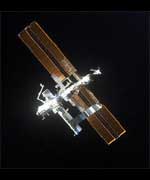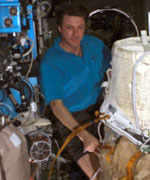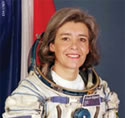The oxygen-producing Elektron in of the International Space Station was restarted today after a troubleshooting procedure by Expedition 9 Commander Gennady Padalka, but shut down again after operating for just over an hour.
Russian specialists decided to forego further troubleshooting until Monday to give them more time to determine why a gas analysis mechanism in the system commanded the Elektron to shut down two other times after Padalka had cleaned and flushed lines in the device.
Despite the intermittent performance of the Elektron, there is plenty of oxygen in the Station?s cabin atmosphere. U.S. flight controllers slightly increased nitrogen levels on board with nitrogen from the Quest airlock tanks, but no further repressurization of the cabin atmosphere is required in the near future. The Elektron?s temporary shutdown has no impact to any Station operations.
After several hours of work on the system in the Zvezda Service Module this morning, Padalka told Russian flight controllers that the reassembled Elektron, which separates water into oxygen for the Station and hydrogen that is vented overboard, had twice run for about five minutes before shutting down. Eventually, Padalka and flight controllers disabled an Elektron gas analyzer sensor system, and the device continued to operate for just over an hour before it commanded itself to shut off again. The Elektron originally shut down on Wednesday, prompting Padalka?s maintenance work.
At the moment, Russian flight controllers believe that a modification in the software that regulates commanding for the gas analyzer could fix the problem early next week.
On Wednesday, Padalka used spare parts sent up on a Russian Progress resupply ship last May to bring a spare liquids unit for the Elektron back to operational status. There are no plans to use the backup unit at the moment, but it is available, if needed. The Progress currently docked to the Station has full oxygen and air tanks and additional oxygen is available in two high-pressure tanks on Quest, if they are needed. A total of 84 Solid Fuel Oxygen Generator canisters, a 42-day supply of oxygen for the crew, also are available, but there are no plans to use any reserve oxygen supplies.
Earlier in the week, Padalka and NASA ISS Science Officer Mike Fincke conducted routine housekeeping tasks and a few post-spacewalk tasks, including the stowage of spacewalking tools and the servicing of the Russian Orlan space suits.
Fincke also conducted optional science activities, including some remaining data takes with a Dutch experiment that helps to characterize the performance of a grooved heat pipe in microgravity. The experiment was brought up to the Station by European Space Agency astronaut Andre Kuipers in April.
Both crewmembers worked with other science and medical experiments this week. Padalka conducted the PLANTS experiment as well as the PROFILAKTIKA experiment. It is designed to study countermeasures to negative physiological effects of lengthy spaceflight.
Fincke also performed proficiency training for the Advanced Diagnostic Ultrasound in Microgravity medical experiment and on Thursday, both crewmembers participated in a bone scanning procedure. That research will not only assist with onboard medical situations but is being developed for possible use in remote areas on Earth.
Padalka and Fincke wrapped up their week with a televised conversation with Native American students at the United Tribes Technical College in Bismarck, ND. It was the featured event during the 35th Annual United Tribes International Powwow. NASA representatives from the Johnson Space Center and the Langley Research Center attended the powwow and tribal meetings to promote NASA education and Explorer Schools.
Padalka and NASA ISS Science Officer Mike Fincke completed their 145th day in space today and their 143rd day aboard the complex.
For information on the crew’s activities aboard the Space Station, future launch dates, as well as a list of opportunities to see the Station from anywhere on the Earth, visit:
http://spaceflight.nasa.gov/
For details on Station science operations provided by the Payload Operations Center at NASA’s Marshall Space Flight Center in Huntsville, Ala., visit:
http://scipoc.msfc.nasa.gov/
The next ISS status report will be issued on Friday, Sept. 17 or earlier, if events warrant.
Original Source: NASA Status Report



